The last decision you should make when choosing which strategy to implement with your hand is whether to hit or stand. In this section, I’ll cover the hitting and standing strategy for hard hands and soft hands
Blackjack Rules for Hitting and Standing
The most frequent playing decision that you will have to make is whether to hit or stand.
- Hitting means to ask for another card (sometimes referred to as “drawing another card”).
- Standing means you are satisfied with your hand and you don’t want any more cards.
- You can stand or hit on any hand that totals 21 or less.
- You must signal the dealer to indicate if you want to hit or stand.
- Use the correct signals when the cards are dealt face up vs. when they are dealt face down.
- In the process of taking a hit, if your hand exceeds a total of 21, you’ve busted and you automatically lose your bet.
- Once you signal to the dealer that you want to stand, that completes your hand for that round.

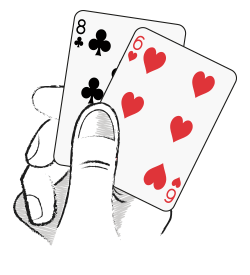 A Few Facts About Hard Hands
A Few Facts About Hard Hands
The worst hands you will get at blackjack are hard 12 through 17. The reason is that no matter what the dealer’s upcard happens to be, you stand to lose more hands than you will win in the long run. One exception: in an s17 game with two or more decks, a 17 vs. a 6 is a slight winner. In other words, virtually all these hands are overall losers for blackjack players. Surprised? Here’s one more gruesome statistic. You are going to be dealt one of these losers about 4 out of every 10 hands.
So what’s a blackjack player to do when 40% of the time you are going to get a 12 through 17 whether you like it or not? Since you can’t change the cards that you are dealt, the best you can do is follow the basic playing strategy for hard (and soft) hands. You’ll still take your lumps but you’ll lose less money in the long run when you follow the basic strategy than if you depend upon divine intervention, or worse, play by the seat of your pants.

Basic Strategy for Hitting and Standing
The following black and white tables and colour-coded charts summarize the hitting and standing basic strategy for single-, double-, and 4/6/8-deck games. They assume that:
- Surrender is not available (if it is, follow the surrender strategy)
- You can double down on any two-card hand (following the doubling down strategy)
- If there are restrictions to hard or soft doubling, see the hitting and/or standing strategy.
The black and white tables and coloured-coded charts contain the strategy for hitting and standing on hard hands, soft hands, and pairs for single-, double-, and 4/6/8-decks. The colour-coded charts for single deck follow the black and white tables for single deck. The same applies for double deck and 4/6/8 decks. In total, there are nine black and white tables and nine colour-coded charts containing the summary for hitting and standing for all games and rules.
Note: The hitting and standing strategies for hard and soft hands are not affected by DAS or NDAS, only whether the dealer stands on soft 17 (s17) or hits soft 17 (h17). Therefore the hitting and standing strategies below for hard and soft hands can be used with either DAS or NDAS. With pair splitting, the strategy is affected by DAS or NDAS, which is why there is one table and chart for pair splitting with DAS, and another with NDAS. Whether or not the dealer stands or hits on soft 17 will depend on the game in question. In most cases the rule will be printed on the table layout. h17 will increase the house edge by around 0.2%, compared to s17.

Single Deck, S17
Hitting and Standing Hard and Soft Hands
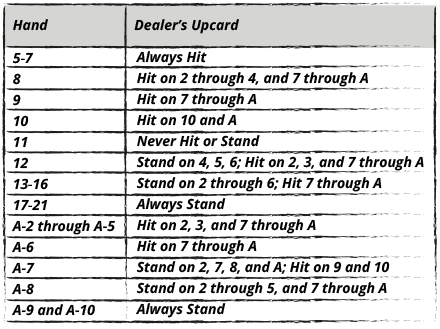 |
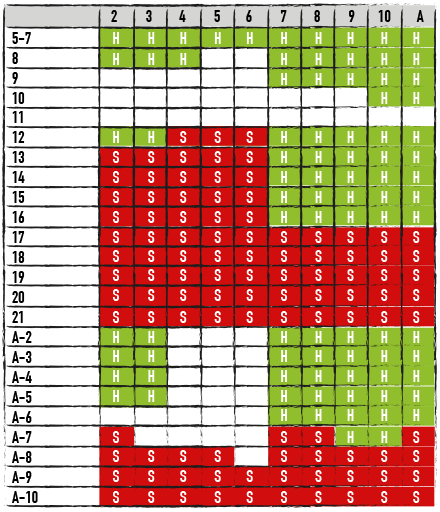 |
Hitting and Standing Pairs (DAS)
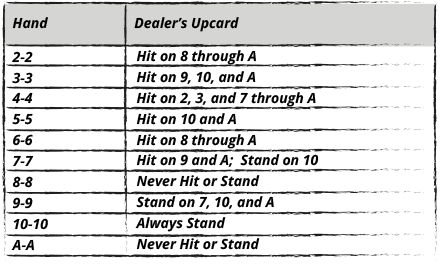 |
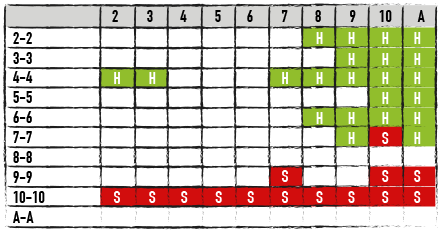 |
Hitting and Standing Pairs (NDAS)
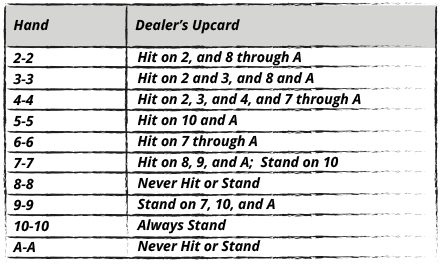 |
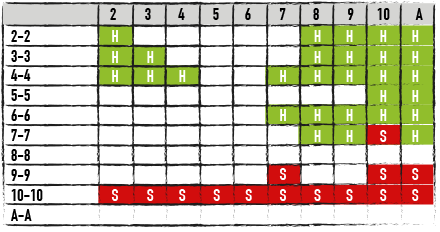 |

Single Deck, H17
Hitting and Standing Hard and Soft Hands
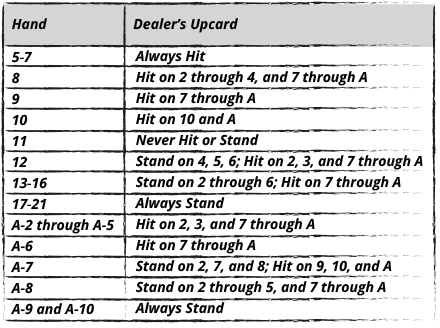 |
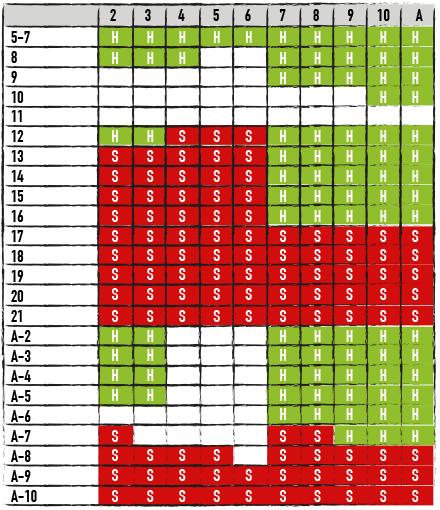 |
Hitting and Standing Pairs (DAS)
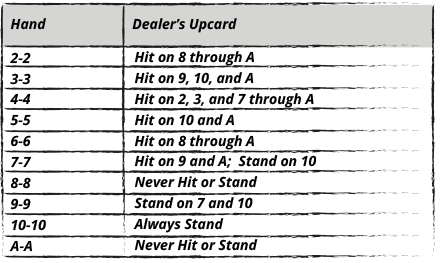 |
 |
Hitting and Standing Pairs (NDAS)
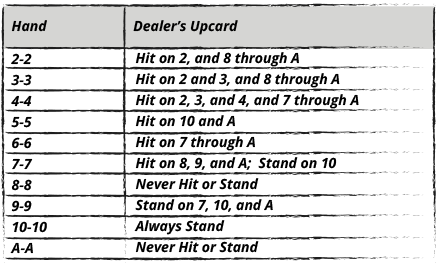 |
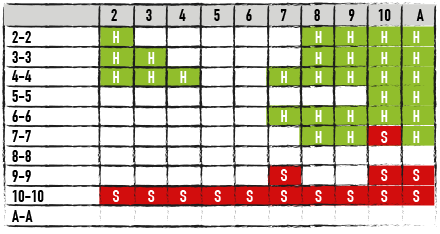 |

Double Deck, S17
Hitting and Standing Hard and Soft Hands
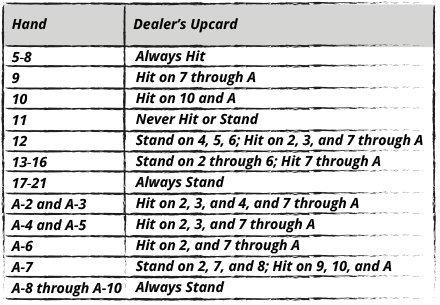 |
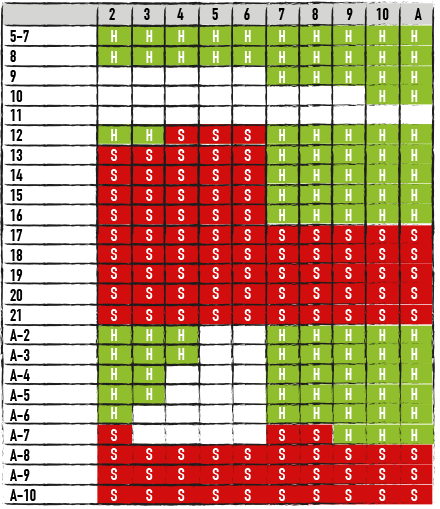 |
Hitting and Standing Pairs (DAS)
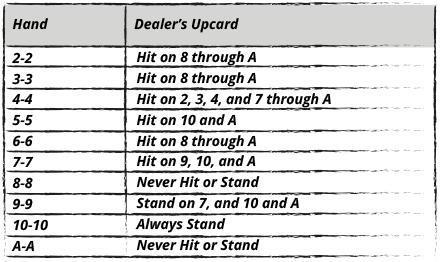 |
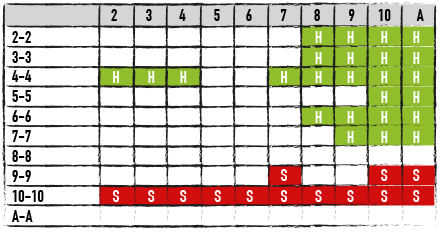 |
Hitting and Standing Pairs (NDAS)
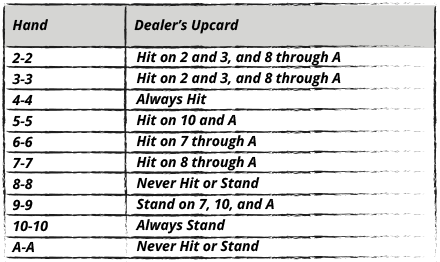 |
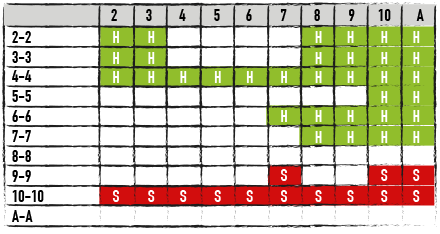 |

Double Deck, H17
Hitting and Standing Hard and Soft Hands
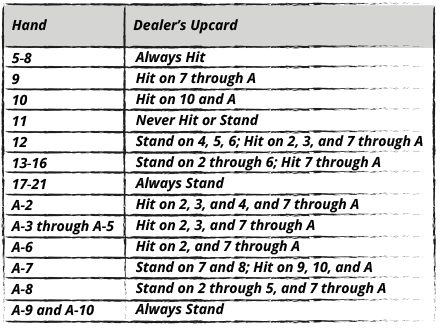 |
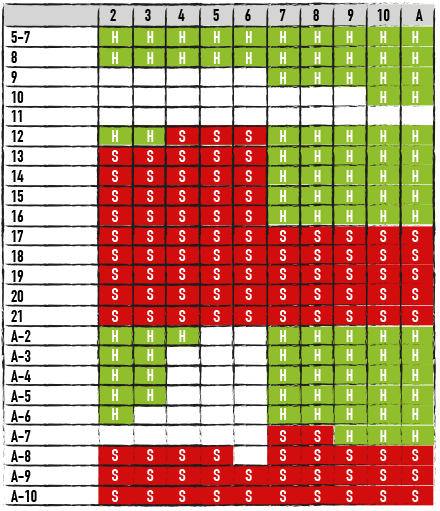 |
Hitting and Standing Pairs (DAS)
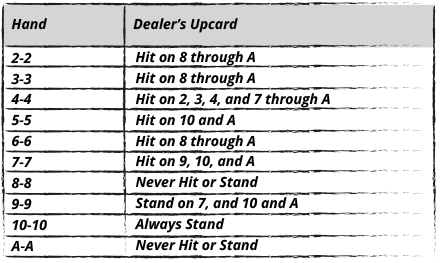 |
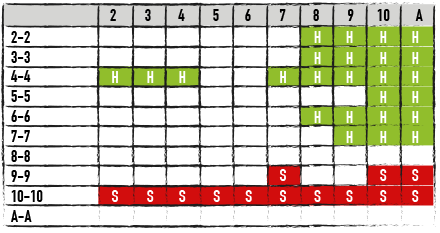 |
Hitting and Standing Pairs (NDAS)
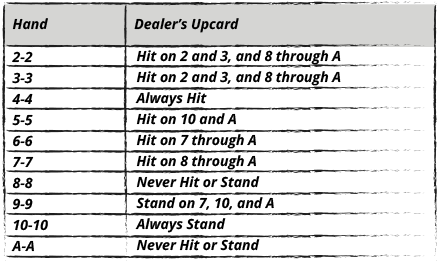 |
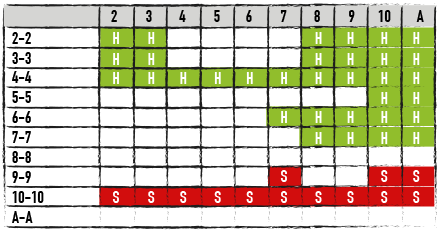 |

4/6/8 Decks, S17
Hitting and Standing Hard and Soft Hands
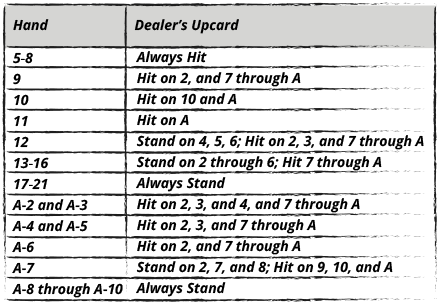 |
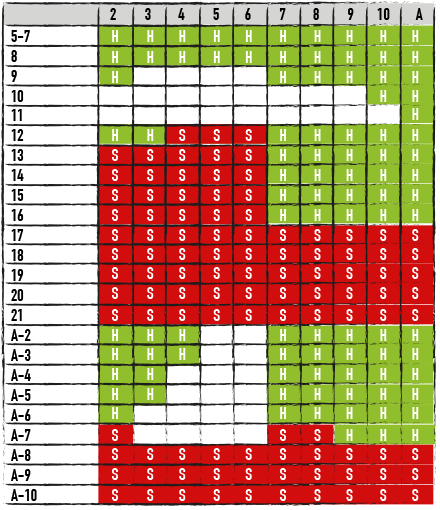 |
Hitting and Standing Pairs (DAS)
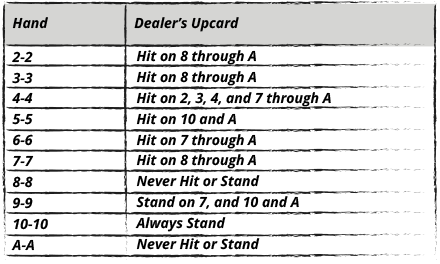 |
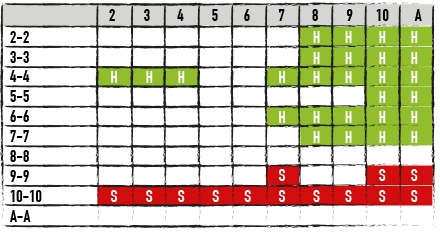 |
Hitting and Standing Pairs (NDAS)
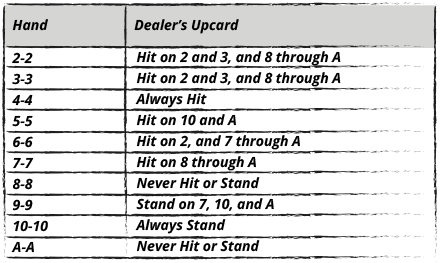 |
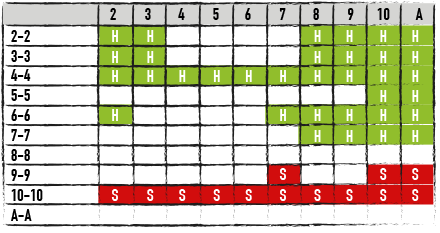 |

4/6/8 Decks, H17
Hitting and Standing Hard and Soft Hands
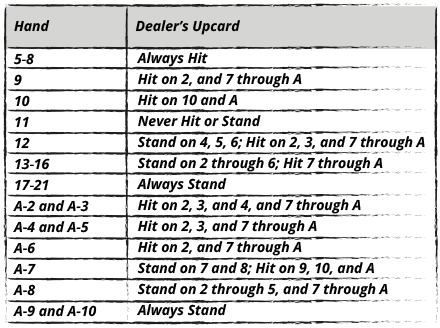 |
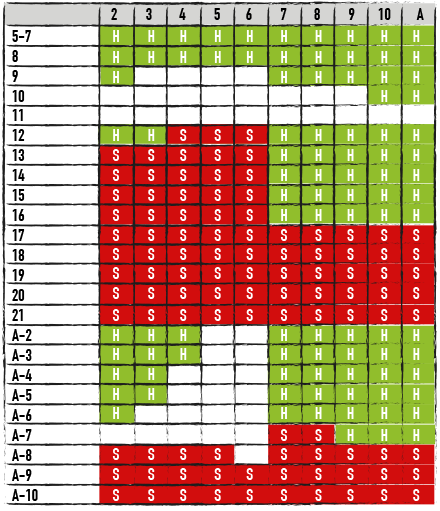 |
Hitting and Standing Pairs (DAS)
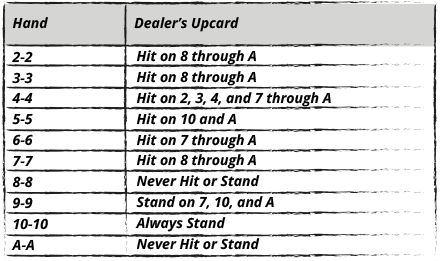 |
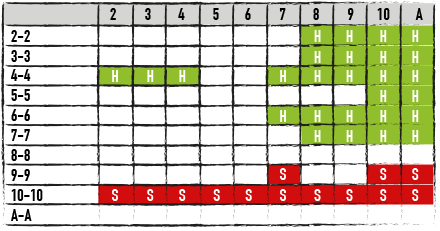 |
Hitting and Standing Pairs (NDAS)
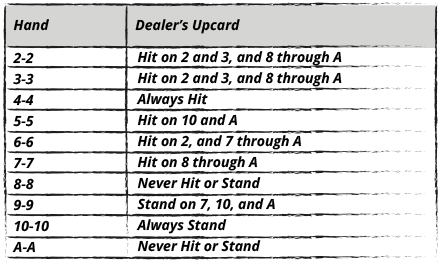 |
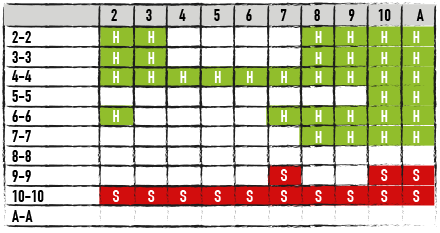 |

Examples
- Single-deck game with h17, you hold 16 and the dealer’s upcard is a 7. You should hit.
- Single-deck game with h17 and NDAS, you hold A-7 and the dealer’s upcard is a 9. You should hit.
- Double-deck game with s17 and DAS, you hold a pair of 9s and the dealer’s upcard is a 7. You should stand.
- Eight-deck game with s17, you hold a 12 and the dealer’s upcard is a 3. You should hit.
- Single-deck game, h17 and NDAS, you hold 4-4 and the dealer’s upcard is a 4. You should hit.
- Double-deck game with S17, you hold A-6 and the dealer’s upcard is a 2. You should hit.
Logic for Hitting and Standing on Hard Hands
The most common mistake made by novice blackjack players is to always stand on their stiff hands because they are afraid to bust. Stiff means a hand that can be busted by a one-card draw; for example a hard 12 through 16. However, this is a big mistake when the dealer’s upcard is a 2 through 6. Since you know the dealer must hit stiff hands by the rules of the game, you should:
- Not risk busting your stiff hand (resulting in an automatic loss) when the dealer’s upcard is 2-6 because she may end up with a stiff hand
- Instead, stand pat, let the dealer draw, and hope she busts
There is one exception to this rule and that’s when you are dealt a 12 and the dealer’s upcard is a 2 or 3. That’s because the dealer is not as weak with a 2 or 3 upcard, as her bust frequency is lower (35% and 37% respectively) compared to when her upcard is a 4, 5, or 6 (40%, 43%, and 42% respectively). Consequently, the percentages are slightly better for:
- Hitting a hard 12 against a dealer’s 2 and 3 upcard rather than standing.
When the dealer shows a 7 through A upcard, there is a strong likelihood she will end up with a pat hand (i.e., a 17 through 21). Therefore, when you hold hard 16 or less, and surrendering, pair splitting or doubling is not an option, the percentages are better if you hit your hand even at the risk of busting until you achieve at least a hard 17.
Logic for Hitting and Standing on Soft Hands
Many novice players stand on soft 17 (A-6) thinking that’s a good total, but this is another big mistake. That’s because you can’t bust with a one-card draw to a soft 13 through 17; therefore it’s worth hitting to try to get to hard 17 or soft 18 or higher.
As a general rule, you should never stand on soft 13 through soft 17. You are either going to double down per the doubling strategy summarized in section 2.4, or hit. Your goal is to get to hard 17 or soft 18 to 21, with one exception. When you hold a soft 18 and the dealer shows a strong 9, 10, or A upcard, the percentages are slightly in your favour to hit (rather than stand) on soft 18. Exception: occasionally, depending on rules, you stand on A-7 vs. A.
Here’s another important point to keep in mind about soft hands. Oftentimes your soft hand will be converted to a hard hand when you hit. For example, suppose you have an A-4 and the dealer shows a 7 upcard. You hit and draw a 10. You’ve converted a soft 15 into a hard 15. Now you must switch and use the hard hand standing/hitting rules, which for hard 15 against a 7, is to hit until you get to 17 or more.
|
BLACKJACK GUIDES
|












